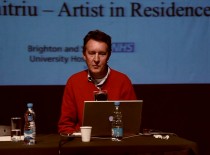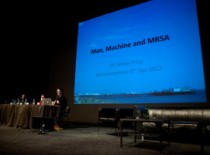Prague - December 6, 2012
Kevin Cole presents his paper within the panel Confronting the Bacterial Sublime: Whole Genome Sequencing, Microbiology and Bioart at International conference MutaMorphosis in Prague, Czech Republic.
Antibiotic-resistant bacteria have become an increasingly dangerous and prevalent threat to the human race. Pathogens now termed as ‘Super-bugs’ have been created by humans through the use and overuse of antibiotics and now threaten our health and wellbeing. These superbugs appear to be evolving these resistance mechanisms at a faster rate than we can discover or create new antibiotics and we are forced to look to alternate methods to tackle and reduce infections.
One of these; Methicillin-Resistant Staphylococcus aureus (MRSA) has now become a major global-healthcare issue. These bacteria can readily live on the skin of humans and in the environment. Certain strains are even suited to dwelling in hospitals amongst antibiotics and stringent cleaning regimens.
Hospital-acquired MRSA and S. aureus infection rates remain high even though they have been targeted by infection control policies as we still do not fully understand the exactly how they are transmitted amongst patients.
With the advent of Whole-Genome Sequencing (WGS) we may now be able to shed light on the exact routes these pathogens take when moving from patient to patient. WGS will allow us to discriminate between bacteria with such high resolution that we may be able to track and even prevent single isolates as they move through hospitals and communities.
We are using WGS alongside a range of conventional methods to attempt to take a snapshot of exactly how S. aureus is acquired by patients in a hospital ICU ward. By sampling patients, ward staff and the environment for S. aureus we hope to use WGS to linkup genetically identical isolates (i.e. the exact same organism) and use this information to identify and characterise exact ‘transmission events’. If we can determine exactly how S. aureus is passed from one patient to another then hopefully infection control interventions can be implemented that will stop the organism in its path.
As we gain greater understanding of how the genes we unravel translate to particular features of bacteria our ability to treat infections will improve. We are now moving to a scientific method whereby instead of merely seeing the phenotypes an organism may present we are now able to detect the genes that determine these phenotypes. WGS can be used not only detect any (potential) outbreaks of particularly contagious strains but also give us knowledge of antibiotic-resistant mechanisms or virulence factors that it may have. Perhaps the near future we may also be able to utilise this method to observe the bacterial evolution in real time so that we may be able to pre-empt potentially threatening mutants that will inevitably emerge.
- Tags:




 Copyright © 2025 ARTISTTALK. All Rights Reserved.
Copyright © 2025 ARTISTTALK. All Rights Reserved.
0 Comments
You can be the first one to leave a comment.